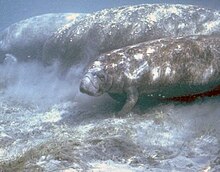Subclass: Theria
Infraclass: Eutheria
Order: Sirenia (manatees and dugongs)

Sirenia is an order of fully aquatic, herbivorous mammals that inhabit rivers, estuaries, coastal marine waters, swamps, and marine wetlands. All four species are endangered.
- Family: Trichechidae
- Genus: Trichechus
- West Indian manatee, T. manatusVU extirpated
- Genus: Trichechus
Order: Chiroptera (bats)
The bats' most distinguishing feature is that their forelimbs are developed as wings, making them the only mammals capable of flight. Bat species account for about 20% of all mammals.
- Family: Noctilionidae
- Genus: Noctilio
- Greater bulldog bat, Noctilio leporinus LR/lc
- Genus: Noctilio
- Family: Vespertilionidae
- Subfamily: Myotinae
- Genus: Myotis
- Dominican myotis, Myotis dominicensis VU
- Genus: Myotis
- Subfamily: Vespertilioninae
- Genus: Eptesicus
- Big brown bat, Eptesicus fuscus LR/lc
- Genus: Eptesicus
- Subfamily: Myotinae
- Family: Molossidae
- Genus: Tadarida
- Mexican free-tailed bat, Tadarida brasiliensis LR/nt
- Genus: Tadarida
- Family: Mormoopidae
- Genus: Pteronotus
- Naked-backed bat, Pteronotus davyi LR/lc
- Genus: Pteronotus
- Family: Phyllostomidae
- Subfamily: Brachyphyllinae
- Genus: Brachyphylla
- Antillean fruit-eating bat, Brachyphylla cavernarum LR/lc
- Genus: Brachyphylla
- Subfamily: Glossophaginae
- Genus: Monophyllus
- Insular single leaf bat, Monophyllus plethodon LR/nt
- Genus: Monophyllus
- Subfamily: Stenodermatinae
- Genus: Ardops
- Tree bat, Ardops nichollsi LR/nt
- Genus: Artibeus
- Jamaican fruit bat, Artibeus jamaicensis LR/lc
- Genus: Sturnira
- Little yellow-shouldered bat, Sturnira lilium LR/lc
- Genus: Ardops
- Subfamily: Brachyphyllinae
- Family: Natalidae
- Genus: Natalus
- Mexican funnel-eared bat, Natalus stramineus LR/lc
- Genus: Natalus
Order: Cetacea (whales)

The order Cetacea includes whales, dolphins and porpoises. They are the mammals most fully adapted to aquatic life with a spindle-shaped nearly hairless body, protected by a thick layer of blubber, and forelimbs and tail modified to provide propulsion underwater.
- Suborder: Mysticeti
- Family: Balaenopteridae (baleen whales)
- Genus: Balaenoptera
- Common minke whale, Balaenoptera acutorostrata
- Sei whale, Balaenoptera borealis
- Bryde's whale, Balaenoptera brydei
- Blue whale, Balaenoptera musculus
- Genus: Megaptera
- Humpback whale, Megaptera novaeangliae
- Genus: Balaenoptera
- Family: Balaenopteridae (baleen whales)
- Suborder: Odontoceti
- Superfamily: Platanistoidea
- Family: Delphinidae (marine dolphins)
- Genus: Delphinus
- Short-beaked common dolphin, Delphinus delphis DD
- Genus: Feresa
- Pygmy killer whale, Feresa attenuata DD
- Genus: Globicephala
- Short-finned pilot whale, Globicephala macrorhyncus DD
- Genus: Lagenodelphis
- Fraser's dolphin, Lagenodelphis hosei DD
- Genus: Grampus
- Risso's dolphin, Grampus griseus DD
- Genus: Orcinus
- Killer whale, Orcinus orca DD
- Genus: Peponocephala
- Melon-headed whale, Peponocephala electra DD
- Genus: Pseudorca
- False killer whale, Pseudorca crassidens DD
- Genus: Stenella
- Pantropical spotted dolphin, Stenella attenuata DD
- Clymene dolphin, Stenella clymene DD
- Striped dolphin, Stenella coeruleoalba DD
- Atlantic spotted dolphin, Stenella frontalis DD
- Spinner dolphin, Stenella longirostris DD
- Genus: Steno
- Rough-toothed dolphin, Steno bredanensis DD
- Genus: Tursiops
- Common bottlenose dolphin, Tursiops truncatus
- Genus: Delphinus
- Family: Physeteridae (sperm whales)
- Genus: Physeter
- Sperm whale, Physeter catodon DD
- Genus: Physeter
- Family: Kogiidae (dwarf sperm whales)
- Genus: Kogia
- Pygmy sperm whale, Kogia breviceps DD
- Dwarf sperm whale, Kogia sima DD
- Genus: Kogia
- Family: Delphinidae (marine dolphins)
- Superfamily Ziphioidea
- Family: Ziphidae (beaked whales)
- Genus: Mesoplodon
- Gervais' beaked whale, Mesoplodon europaeus DD
- Genus: Ziphius
- Cuvier's beaked whale, Ziphius cavirostris DD
- Genus: Mesoplodon
- Family: Ziphidae (beaked whales)
- Superfamily: Platanistoidea
Order: Carnivora (carnivorans)
There are over 260 species of carnivorans, the majority of which feed primarily on meat. They have a characteristic skull shape and dentition.
- Suborder: Pinnipedia
- Family: Phocidae (earless seals)
- Genus: Neomonachus
- Caribbean monk seal, Neomonachus tropicalis EX
- Genus: Neomonachus
- Family: Phocidae (earless seals)